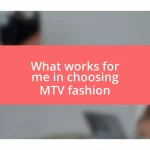Key takeaways:
- Understanding and recognizing self-doubt as a common aspect of the artistic journey can help artists transform their vulnerabilities into creativity.
- Building a supportive network and community fosters encouragement and offers shared experiences that alleviate feelings of isolation.
- Celebrating small achievements, setting realistic goals, and practicing self-compassion significantly boost confidence and nurture artistic growth.

Understanding self-doubt as an artist
Self-doubt is like a shadow that often looms large over us as artists, whispering that our work isn’t good enough. I remember sitting in my studio, looking at a half-finished painting and feeling an overwhelming sense of inadequacy. It struck me then—hadn’t Van Gogh faced similar struggles? That realization made me feel a bit less alone.
When I think back to my early days, I can recall standing before my peers at art school, filled with a mix of pride and paralyzing anxiety. How could I showcase my creations when those around me seemed so effortlessly talented? Each critique felt like a dagger to my confidence, but I now see those moments as stepping stones, not shackles.
As I delved deeper into understanding self-doubt, I began to realize it’s not just a personal battle; it’s part of the artistic journey for many. Isn’t it fascinating that the very emotions we wrestle with can fuel our creativity? Embracing self-doubt challenged me to tap into my vulnerabilities, pushing me to create art that felt more honest and raw.

Recognizing triggers of self-doubt
Recognizing the triggers of self-doubt as an artist has been crucial for my growth. I remember vividly the moment I stumbled upon my first major trigger: social media. Scrolling through endless portfolios of artists showcasing flawless pieces can lead to an immediate sense of inadequacy. It’s as if with each like and perfect critique, the voices in my head grew louder, chanting that I was falling short. I had to learn to set boundaries with my digital consumption and reflect on my unique journey instead.
Here are some common triggers that might resonate with fellow artists:
- Comparison to peers or established artists
- Negative feedback from critics or audiences
- Perfectionism and the fear of flaws
- Observing gaps in one’s skill level versus aspirations
- Personal life stressors that bleed into creative work
Each trigger, once identified, turned into an opportunity for introspection. By confronting these moments head-on, I shifted my perspective. Instead of viewing them as threats, I began to see them as cues for self-reflection and growth.

Techniques to boost confidence
When I took a moment to breathe and find mindfulness in my art process, I discovered a remarkable boost in my confidence. A simple meditation session before creating helped clear my mind. Instead of worrying about the end result, I focused on enjoying the act itself, allowing my creativity to flow freely. This shift transformed my approach—every brushstroke felt empowered, free from the shackles of self-doubt.
Setting small, achievable goals has been another game-changer in my journey. For instance, rather than aiming to create a masterpiece, I began dedicating an hour daily to sketching, free from judgment. These small wins built my confidence gradually, allowing me to celebrate progress instead of perfection. Over time, they built a solid foundation that reassured me of my capabilities as an artist.
I found that surrounding myself with a supportive community made all the difference. Engaging with fellow artists who shared their struggles and triumphs helped me realize I wasn’t isolated in my feelings of self-doubt. Their encouragement reminded me that art is a collaborative journey; we all face challenges. This connection not only lifted my spirits but also fostered an environment where we inspire and uplift each other, creating a sense of belonging.
| Technique | Description |
|---|---|
| Mindfulness | Practicing meditation to clear the mind and focus on the joy of creating. |
| Setting Small Goals | Establishing achievable tasks helps build confidence through small victories. |
| Building Community | Engaging with a supportive group of artists fosters encouragement and a sense of belonging. |

Building a supportive network
Finding a supportive network has been a transformative element in my artistic journey. I reached out to local artists through workshops and community events, which surprised me; I assumed everyone was too focused on their own work to connect. But I quickly discovered how a shared space creates comfort—sharing our struggles turned out to be an eye-opening experience. Have you ever felt like the only one struggling? Trust me, you’re not alone.
As I mingled with peers, I found that vulnerability fosters deep connections. Once, during a group critique, an artist confessed her battle with self-doubt over a piece she had poured her heart into. Hearing her story resonated with me and, in turn, I shared my own fears about a project. That moment of candidness reinforced our connection. I realized that our challenges don’t diminish our art; instead, they humanize it and encourage authenticity. Isn’t it beautiful how sharing our vulnerabilities can uplift us?
Additionally, participating in online artist forums became a lifeline for me. I was amazed at how the digital world could create genuine support and camaraderie. Every time someone praised my work or offered constructive feedback, it reminded me that community doesn’t always have to be physical. It’s reassuring to know that, at any hour, there’s a network of creators who can understand and support one another. Have you tapped into such networks yet? The potential for growth and encouragement is all around us.

Setting realistic artistic goals
Setting realistic artistic goals is crucial for nurturing growth and building confidence. In my experience, I found that breaking down larger aspirations into manageable steps made my tasks feel less daunting. For example, instead of declaring, “I will create a gallery-worthy painting this month,” I shifted my focus to “I will experiment with color blending techniques this week.” This little change eased the pressure and sparked joy in my process.
I recall a time when I struggled with the idea of finishing my first series. I became overwhelmed, thinking I had to produce something spectacular. Instead, I started setting a goal of creating just one piece each week. It was liberating! Each time I’d complete a piece, I felt a rush of accomplishment, no matter the outcome. Have you ever noticed how small victories in art can shift your entire mindset? It’s those moments that remind us of our passion and capabilities.
What I’ve learned is that setting realistic goals creates a pathway to artistic growth rather than a wall of pressure. Each step taken toward those goals, no matter how small, adds up over time. When I celebrated a finished piece, it wasn’t just about the artwork itself—it was about acknowledging my commitment to my craft. How often do we pause to reflect on our progress? Taking that moment can be a game-changer in reinforcing our journey as artists.

Practicing self-compassion techniques
Practicing self-compassion techniques significantly shifted my artistic mindset. I remember the first time I tried journaling about my feelings as an artist. Instead of criticizing myself, I wrote down my insecurities and then responded to them with kindness. It felt incredible to treat myself as I would a close friend—offering understanding rather than harsh judgments. Isn’t it interesting how simple shifts in dialogue can resonate so deeply within us?
One particular afternoon, I faced a creative block that made me want to throw my brushes aside. Instead of spiraling into self-doubt, I sat quietly and repeated affirmations: “It’s okay to struggle; creating is a journey, not a race.” This practice of self-talk transformed my frustration into a sense of calm. Have you ever tried saying something nice to yourself when the universe seems against you? It’s a small but powerful practice that can change how we navigate challenges in art.
I’ve also found that incorporating mindfulness into my routine enhances my self-compassion. Meditation, even just for ten minutes, allows me to breathe and reset my perspective. During one session, I visualized my inner critic as a small cloud hovering over me, and instead of letting it rain doubt, I chose to let it drift away. That simple image was liberating and reminded me that I control how I react to my fears. When was the last time you took a moment to observe, rather than judge, your feelings as an artist? It’s a practice worth exploring.

Celebrating small artistic achievements
There’s something incredibly empowering about taking a moment to celebrate those small artistic achievements. I recall a day when I finished a particularly challenging sketch that had been sitting on my desk for weeks. Instead of just moving on to the next task, I rewarded myself with a little treat—my favorite coffee and a moment to admire what I had created. It felt wonderful to acknowledge that small milestone, reinforcing a sense of joy in my artistic journey. Have you ever thought about how rewarding it can be to just pause and appreciate your work, no matter its size?
Reflecting on my experiences, I’ve come to realize that each tiny success cultivates a sense of momentum. I remember the first time I shared a simple doodle on social media and received encouraging comments from friends. That feeling of validation was invaluable! It turned something I considered trivial into a spark of motivation that fueled my subsequent projects. Does sharing your work, even the small stuff, give you the same rush? I firmly believe that celebrating these moments encourages us to take on bigger challenges.
It’s interesting how the act of celebration shifts our mindset. I learned that even the most minor victories, like completing a study or trying a technique for the first time, can be stepping stones toward greater confidence. Recently, I dedicated time to create an abstract piece that didn’t quite meet my idea of perfection. Instead of dismissing it, I decided to celebrate the process of creation itself. I took a picture, wrote about what I learned, and gave it a place on my wall. It served as a reminder that growth happens in layers, sometimes hidden behind those initial attempts. How often do we remind ourselves that every brushstroke counts? Each small achievement builds the narrative of who we are as artists.















